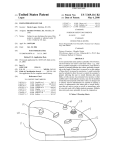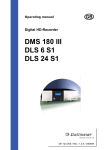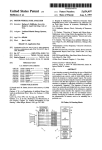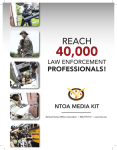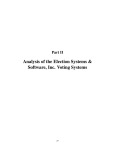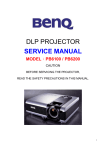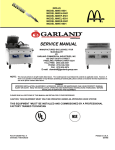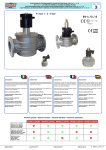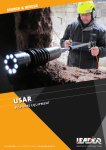Download Textured cushion for keyboard cursor control stick
Transcript
US006724369B2 (12) United States Patent (10) Patent N0.: US 6,724,369 B2 (45) Date of Patent: *Apr. 20, 2004 Slotta (54) TEXTURED CUSHION FOR KEYBOARD 5,488,206 A CURSOR CONTROL STICK 5,504,502 A 5,568,987 A 4/1996 Arita et al. 10/1996 FranZ 5,570,112 A 10/1996 Robinson (75) Inventor: Mark R. Slotta, Highland, MI (US) ' . 5,670,988 A - 5,691,747 A (73) Asslgnee' GIV’ LLC’ Hlghland’ MI (Us) . (ak) . Nome: . 5,694,123 A . . 5,701,142 A 5,705,778 A * 5,708,562 A U-S-C- 154(b) by 0 days~ 5,712,660 A 12/1997 Brown et al. 1/1998 Matsuietal. ........... .. 200/11 R 1/1998 Agata et a1_ 1/1998 Martin 5/1998 5,798,754 A * 8/1998 Selker et al. ............. .. 345/161 Baba ........................ .. 345/157 (List continued on next page.) OTHER PUBLICATIONS Jul_ 12’ 2002 IBM ThinkPad 750 and 750C User’s Manual pp. 4—27 PriOI‘ PubliCatiOIl Data through 4—29, dated prior to invention. Santoprene Thermoplastic Rubber. Datasheet. [online]. US 2004 0056841 A1 M / at Advanced Elastomer Systems ’ L.P. [retrieved on Oct. 30 ’ . . 25 2004 ’ 2000]. Retrieved from the Internet <URL:WWW.santo Related US Application Data (60) Amano ..................... .. 345/167 12/1997 Selker et al. * (21) Appl.No.: 10/194,715 (65) 11/1997 5,754,166 A Clalmer' Filed: 1/1996 Wu .......................... .. 200/6 A 9/1997 Tickle * sublectto any dlsclalmeritheterm Ofthls patent is extended or adJusted under 35 This patent is Subject to a terminal dis_ (22) * prene.com/aes/santoprene.html>. L' t Continuation-in-part of application No. 09/703,041, ?led on Oct. 31, 2000, which is a continuation-in-part of application No. 09/281,126, ?led on Mar. 29, 1999, now Pat. No. 6,140,998, which is a division of application No. 08/717, 220, ?led On Sep. 26, 1996, now Pat. NO. 5,889,508. 7 t' d t . ( 15 Con lnue on neX page) Primary Examiner_Regina Liang - ~ _ - Assistant Examiner Jenmfe? T' Nguyen, _ (74) Attorney) Agent) or Flrm—MaCM111an> Sobanskl & Todd, LLC (51) Int. Cl. ................................................ .. G09G 5/08 (52) US. Cl. ..................... .. 345/161; 345/157; 345/158; (57) _ 345/156; 345/160; 345/163 Fleld Of Search ............................... .. A gel cushion that can be attached to an existing cursor pointing device (Control Stick) on a Computer or keyboard, 345/156’ 160’ 161’ 163 , References Clted US PATENT DOCUMENTS or be integrally formed With the cap during manufacture. The gel cushion is ?exible enough to prevent tissue damage to the user’s ?ngers due to repetitive motions over an extended period of use, yet ?rm enough to transmit the desired pressure to the control stick. The gel cushion (56) 3’292’397 A 8/1975 Eff/Ore et a1‘ designed to be used on an existing control stick can be 1836382 2 * H515; """""""""""" " 5’087’904 A 2/1992 D evolp'i' """"""""""" " 51347008 A 7/1992 Alm 5,290,115 A 5,407,285 A * 3/1994 Little ABSTRACT applied With an adhesive to a cap, or With a frictional ?t directly to the control stick. The gel cushion is designed to be easily installed and replaced When Worn. ....................... .. 400/491 4/1995 Franz 103 Claims, 14 Drawing Sheets l2. '7 \NS\DE OF COVER m . \5 WHEN CLO$ED US 6,724,369 B2 Page 2 U.S. PATENT DOCUMENTS 5,870,082 5,889,507 5,889,508 6,019,534 6,040,758 6,057,540 6,135,476 6,140,998 6,239,786 6,271,834 6,353,431 6,390,423 6,400,354 2/ 1999 3/ 1999 3/ 1999 2/2000 3/2000 Selker et a1. Engle et a1. Slotta Heins Sedor et 81. 5/2000 Gordon et a1. 10/2000 Dickie et a1. * 10/ 2000 5/2001 8/2001 3/2002 5/2002 OTHER PUBLICATIONS TPE Applications for Broad Industry Needs. Information sheet [online]. Advanced Elastorner Systems, L.P. [retrieved on Oct. 30, 2000]. Retrieved from the Internet <URL: WWW.sant0prene.corn/aes/applications.htrn1>. IBM ThinkPad R40. CNET Reviews, 2003 [retrieved May Slotta ....................... .. 345/161 28, 2003]Retrieved from Internet: <http://c0rnputers.cnet. c0rn/hardWare/0—1027—405—20833353—1.htrn1>. Burry et al. May et a1. IBM ThinkPad R40. PC Watch Japan, Jan. 29, 2003; [re trieved 2003—05—28] Retrieved from Internet: <http://pc. Poole et a1. Watch.irnpress.c0.jp/d0cs/2003/0129/ibrn.htrn>. DanZyger et a1. 6/2002 Pin-Chien * cited by examiner U.S. Patent Apr. 20, 2004 Sheet 1 0f 14 US 6,724,369 B2 I: U D m J! "716. l F \ICRw ms mwEH om. co.W0E5 4 _T Ill] U.S. Patent Apr. 20, 2004 2O Sheet 2 0f 14 US 6,724,369 B2 22. 24 ".r" I6. 4 32 30 as 54 IG. 5 %34 3O :‘I6. 6 U.S. Patent Apr. 20, 2004 Sheet 3 0f 14 US 6,724,369 B2 PROVIDE A CURSOR POINTING DEVICE (CONTROL STICK) WITH A CAP HAVING A FIRST HARDNESS 100 / PROVIDE A CUSHION HAVING AN OUTER SURFACE OF A SECOND HARDNESS LESS THAN SAID FIRST HARDNESS -—20O / 300 AFFIX THE SOFT CUSHION TO THE CAP U.S. Patent Apr. 20, 2004 Sheet 4 0f 14 US 6,724,369 B2 U.S. Patent Apr. 20, 2004 Sheet 5 0f 14 US 6,724,369 B2 U.S. Patent Apr. 20, 2004 Sheet 6 6f 14 US 6,724,369 B2 f‘ 500 16.11 f 500 510 508 504 16.12 U.S. Patent Apr. 20, 2004 Sheet 7 0f 14 US 6,724,369 B2 f- 500' f 500' 513' 510’ 514’ 509, 504 502' 508' -—'::_'IG. 14 U.S. Patent Apr. 20, 2004 Sheet 10 0f 14 US 6,724,369 B2 U.S. Patent Apr. 20, 2004 Sheet 11 0f 14 US 6,724,369 B2 800 20a_i__ _t20a 830 804 / -—::'IG. 20 830 -—_-'FIG. 20a / U.S. Patent Apr. 20, 2004 Sheet 12 0f 14 87 804 __:_'IG.21 US 6,724,369 B2 U.S. Patent Apr. 20, 2004 Sheet 13 0f 14 US 6,724,369 B2 r800" 830" :_'IG.22 U.S. Patent Apr. 20, 2004 Sheet 14 0f 14 US 6,724,369 B2 PROVIDE A FIRST MOLD FOR MOLDING ONE OF LOWER /\451 PORTION AND UPPER PORTION V INSERT FIRST MATERIAL CURING TO A FIRST DUROMETER _,/“452 IN THE FIRST MOLD V PROVIDE A SECOND MOLD IN SHAPE OF THE OTHER OF THE /-453 UPPER AND LOWER PORTIONS T V MOvE PARTIALLY CURED FIRST MATERIAL FROM THE FIRST MOLD TO THE SECOND MOLD 454 ~/ V INJECT SECOND MATERIAL CURING TO SECOND DUROMETER INTO /’\455 SECOND MOLD IN CONTACT WITH PARTIALLY CURED FIRST MATERIAL V REMOvE BONDED FIRST AND SECOND MATERIALS FROM SECOND MOLD ,-\ 456 US 6,724,369 B2 1 2 TEXTURED CUSHION FOR KEYBOARD CURSOR CONTROL STICK control stick during a representative task, such as Word processing, Will typically be at least every ten minutes, on average, and may be much more frequently, depending on the particular task and the particular user. CROSS REFERENCE TO RELATED APPLICATIONS This application is a Continuation-In-Part of US. patent application Ser. No. 09/703,041, ?led on Oct. 31, 2000, Which Was a Continuation-In-Part of US. patent application Ser. No. 09/281,126, ?led on Mar. 29, 1999, now US. Pat. No. 6,140,998, Which Was a Divisional of Application Ser. No. 08/717,220 ?led Sep. 26, 1996, now US. Pat. No. Another type of a cap for a control stick has a hard textured outer surface. For example, one knoWn control stick is equipped With a cap Which is stippled With bumps Which are about the same siZe and spacing as the abrasive on 150 grit sandpaper. While this approach may help prevent the 10 slipping common With the earliest model cap, the textured cap is still irritating to the ?nger of a user When used extensively, even With the lighter touch alloWed by the 5,889,508. textured surface. The uneven and relatively hard surface of such caps still can cause in?amed tissue, bruising, soreness BACKGROUND OF THE INVENTION 15 This invention relates in general to a computer-input device and in particular to a cursor-pointing device (cursor control stick), of a notebook-type portable computer or similar device. A ?nger mouse or cursor control stick, as used in this application, is a man-machine interface device, Which con trols the motion of a computer display cursor. In particular, a control stick is a type of miniature joystick, Which is intended to be operated by the tip of one ?nger of the user. Typically, a control stick is mounted in a central location on a computer keyboard, such as betWeen the “G”, “H” and “B” keys on a standard “QWERTY”-type keyboard. The and ?nger fatigue in users Which limits their ability to comfortably use such a control stick for periods of extended use. The present invention provides a “cushioned” cap for a control stick, Which cap may suitably be formed from tWo 20 materials having different durometers (measures of hardness), With a ?nger contact surface Which provides the needed ?nger-to-cap friction to easily use the control stick to move the cursor With a light touch, and Which is formed of a relatively soft material, so that the cap does not irritate the 25 body tissues of the user or result in ?nger fatigue, even after periods of extended use. Asoft texturing may be added to the ?nger contact surface. control stick has a position sensing mechanism, Which Various objects and advantages of this invention Will detects horiZontal pressure in any horiZontal direction. The cursor moves in a direction that corresponds to the direction of pressure exerted on the control stick and, in some embodiments, at a speed that corresponds to the amount of pressure exerted on the control stick. The control stick includes an elongated shaft. The shaft of the control stick has a small diameter, thus alloWing the control stick to be 30 Heins, US. Pat. No. 6,019,534, discloses a gripping device for a Writing instrument With a plurality of annular ribs formed of soft rubber With an internal gel ?lled cham ing detailed description of the preferred embodiment, When read in light of the accompanying draWings. BRIEF DESCRIPTION OF THE DRAWINGS 35 mounted betWeen the keys of the computer keyboard With out causing the placement of the keys to vary greatly from that expected by an experienced user. A cap is typically removably mounted on the upper end of the control stick shaft, in order to provide an enlarged contact surface for a user to press against on the small diameter shaft of the control stick. become apparent to those skilled in the art from the folloW 40 FIG. 1 is a perspective vieW of a typical portable com puter employing a control stick having a cushioned cap in accordance With this invention. FIG. 2 is a side vieW, partly in section, of the control stick illustrated in FIG. 1. FIG. 3 is an enlarged sectional side vieW of the cap and the control stick illustrated in FIGS. 1 and 2. FIG. 4 is a side vieW of the cushioned cap illustrated in FIGS. 1 through 3. 45 ber. It is knoWn to use a gel material con?ned in a chamber as is shoWn in Heins. SUMMARY OF THE INVENTION FIG. 5 is a sectional side vieW of a second embodiment of a cushioned cap in accordance With this disclosure. FIG. 6 is a bottom plan vieW of the cap illustrated in FIG. 5. FIG. 7 is a ?oWchart illustrating a method of manufac turing a control stick in accordance With this disclosure. 50 Some models of control sticks have a cap With a hard smooth surface, Which became slippery during use from FIG. 9 is a side sectional vieW of the gel cushion of FIG. perspiration or a build-up of natural body oils. Thus a user 8. has to press their ?nger With relatively great force against the cap to prevent their ?nger from slipping on the surface of the FIG. 8 is perspective vieW of a gel cushion for a keyboard cursor control stick. 55 FIG. 10 is a vieW similar to FIG. 9, except shoWing an cap. The need to press hard on the cap makes control dif?cult, since the user cannot use the ?nesse and delicate alternate embodiment of the gel cushion. movements typically needed for rapid, accurate cursor movement. Also, pressing hard on the control stick is alternate embodiment of the gel cushion. FIG. 12 is a bottom plan vieW of the gel cushion illus physically tiring to the ?nger, hand and forearm muscles of trated in FIG. 11. FIG. 13 is a vieW similar to FIG. 11, except shoWing an FIG. 11 is a vieW similar to FIG. 9, except shoWing an a user, and causes irritation, in?ammation, and bruising of the ?nger tissue after a period of extended use. A period of extended use, as used in this application, alternate embodiment of the gel cushion. FIG. 14 is a bottom plan vieW of the gel cushion illus means a period of use of more than about one hour, and generally more than four hours and less than tWelve hours. During such period of use, the user frequently manipulates the control stick. The frequency of manipulation of the 65 trated in FIG. 13. FIG. 15 is a vieW similar to FIG. 11, except shoWing an alternate embodiment of the gel cushion and With stick guide. US 6,724,369 B2 3 4 FIG. 16 is a bottom plan vieW of the gel cushion illus trated in FIG. 15. FIG. 17 is a vieW similar to FIG. 13, except showing an alternate embodiment of the gel cushion and With stick prior art cap, such as a cap supplied With the TrackPoint II control stick, is made of a relatively hard elastomeric material. During testing, a probe having a contact surface of approximately 1 square millimeter Was pressed against such guide. a cap to cause the probe to de?ect the surface of the cap FIG. 18 is a bottom plan vieW of the gel cushion illus trated in FIG. 17. FIG. 19 is a vieW similar to FIG. 16, With the gel cushion deformed under the pressure of a user’s ?nger. grams Was required to compress the surface of the cap inWardly this small amount. In contrast, one embodiment of the cushion 20 of the present invention required a force of approximately 0.25 millimeters. Aforce of approximately 15 1O FIG. 20 is a cross sectional vieW of the cushioned cap illustrated in FIG. 18. FIG. 20a is an enlarged top vieW of a third embodiment of the cushioned cap With textured surface illustrated in FIG. 20, taken along the line 20a—20a. ness (or “durometer”) Which Would permit a probe having a 15 FIG. 21 is a cross sectional vieW of the cushioned cap invention has a hardness such that only 5 grams of force is required to cause a probe having a contact surface of 1 square millimeter to de?ect the surface of the cushion 20 by at least 0.25 millimeters. 21, taken along the line 21a—21a. FIG. 22 is similar to FIG. 18, except shoWing an alternate embodiment of the textured surface. FIG. 23 is a cross sectional vieW of the cushioned cap 25 Referring noW to the draWings, FIGS. 1 through 6 illus phantom line 19, but Will resiliently return to the position indicated by the solid outline of the cushion 20. The resil trate a ?rst embodiment of a control stick, indicated gener ally at 10, according to this invention. The illustrated control 35 computers sold by the International Business Machines Corporation. HoWever, it Will be appreciated, in light of the folloWing disclosure, that the invention may be practiced on control devices other than such miniature joysticks. The various devices such as computers, cellular phones, MP3 Referring to FIGS. 3 and 4, the cushion 20 is, preferably, players, and personal digital assistants. a disk of material having a generally semi-circular cross The control stick 10 is mounted in a keyboard 12 of a mounted display screen 15. The control stick 10 is mounted iency of the cushion 20 alloWs the cap 18 to have an enlarged contact surface area and greater height above the keyboard 12 for increased comfort of the user, Without having to increase the spacing betWeen the display screen 15 and the keyboard 12. It Will be appreciated by those skilled in the art that the cushion 20 Will preferably not be made from a material Which Would damage or stick to the display screen 15 if the display screen 15 contacts the cushion 20. cursor control stick of the present invention can be used in typical notebook-style microcomputer 14 having a pivotally Preferably, the cushion 20 also provides a high coef?cient of friction With the user’s ?nger to permit easy positioning of the control stick 10. The polyurethane foam of the cushion 20 is yielding to a degree dependent upon the thickness of the cushion 20. The thickness of the cushion 20 can easily be modi?ed during manufacture to any desired thickness. Referring to FIG. 2, When the display screen 15 is folded doWn over the keyboard 12 for storage, as is typical for most notebook computers, the display screen 15 may contact the cushion 20. The cushion 20 is ?attened as indicated by the DETAILED DESCRIPTION OF THE PREFERRED EMBODIMENT stick 10 is a miniature joy stick, such as the Trackpoint, Trackpoint II, or Trackpoint III control sticks on notebook contact surface of approximately 1 square millimeter to de?ect the surface of the cushion 20 by at least 0.25 millimeters When urged by a force of 10 grams, Would generally be acceptable. The preferred embodiment of the illustrated in FIG. 18. FIG. 21a is an enlarged top vieW of a fourth embodiment of the cushioned cap With textured surface illustrated in FIG. illustrated in FIG. 22. FIG. 24 is a ?oWchart illustrating a method of manufac turing a gel cushion in accordance With this disclosure. only 5 grams to be exerted by the probe to compress the surface of the cushion 20 the same distance. According to the invention, a cushion 20 having a measurement of hard section. HoWever, the cushion 20 may have any suitable 45 at a ?rst end (not shoWn) to the microcomputer 14, betWeen the keys of the keyboard 12. Acap 18 is removably mounted shape, such as that of a ?at-ended or holloW-ended cylinder. In the illustrated embodiment, the cushion 20 has a convex end 22, and a second end 24. The convex end 22 is the contact surface of the cushion 20, that is, the surface that the on the other end 21 of the control stick 10. The control stick user of the control stick 10 Will contact to move the control 10 is usually made of a plastic material, and translates the stick 10. The convex end 22 Will generally be a surface pressure on the cap 18 into a command to move a cursor on providing a good frictional interface. In the preferred embodiment, the convex end 22 is a sealed, smooth, easily a video display of the computer 14. The cap 18 of the control stick 10 is made of a relatively hard elastomeric material. At least a central portion of the outer surface 17 of the cap 18 is provided With an attached cleaned surface, such as a closed cell skin formed on polyurethane foam. The resiliency of the cushion 20 permits 55 cushion 20. The cushion 20 can be made of any resilient material that can be attached to the outer surface 19 of the cap 18. Examples, Which may be suitable materials, include the cushion 20 to be deformed and still provide excellent friction, even When the surface thereof is smooth. HoWever, if desired, the surface of the convex end 22 may be textured or knurled. The second end 24 of the cushion 20 Will be soft rubber, soft foam, and polyurethane foam. The preferred attached to the outer surface 19 of the cap 18 on the control material for the cushion 20 is polyurethane foam such as the stick 10. In the preferred embodiment, a suitable adhesive is type used in expandable earplugs. This type of foam product used to attach the cushion 20 to the outer surface 19 of the cap 18. FIG. 5 is a sectional vieW of a second embodiment of the provides a ?nger contact surface that is relatively soft so as not to damage the tissues in the ?nger of a user during periods of extended use. Hardness can be characteriZed by measuring the force applied to a given area Which is required to compress or de?ect a material a given distance. For example, a typical cushion of this invention, indicated generally at 30. The 65 cushion 30 is generally cylindrical and includes a convex end 32, and a relatively ?at end 33 opposite the end 32. Although in the illustrated embodiment the end 32 is US 6,724,369 B2 5 6 convex, the end 32 may be formed to any suitable shape, cavity. Such a ?ange of material Would restrict the siZe of the opening into the cavity to a diameter Which is less than the diameter of the cap 18, and thus retain the cushion on the cap such as a ?at or a concave surface, as may the end 22 of the cushion 20. A recess 34 is de?ned in the cushion 30, Which generally conforms to the outer surface of the end 21 of the control stick 10. For example, as shoWn in FIG. 6, the recess 34 may have a square perimeter, if the end 21 of the control stick 10 is square in cross-section. The control stick 10 extends into the recess 34. Preferably, to install the cushion 30 onto the control stick 10, a suitable adhesive is applied to the upper end 21 of the control stick, to the interior surface of the recess 34 in the cushion 30, or to both the upper end 21 of the control stick and to the interior surface of the recess 34 in the cushion 30. The cushion 30 is placed on the end 21 of the control stick 10 so that the cushion 30 adheres to the end 21 of the control stick 10. Of course, the cushion 30 could also be af?xed to the control stick 10 by a resilient ?t betWeen the recess 34 of the cushion 30 and the end 21 of the control stick 10. The cushion 30 is comprised of a soft material to permit use for an extended period of time Without 18, either alone or in combination With a suitable adhesive. The opening into such a cushion could be resiliently expanded to slip the cushion onto the cap 18 during assembly, or When the cushion is replaced. Although the preferred embodiment of the cushion 20 or 10 15 30 is for use on a portable notebook computer 14, it is envisioned that the cushion 20 or 30 could be used on any keyboard or in any convenient location on any instrument requiring a control stick-like movement. It is contemplated that the cushions 20 or 30 of the present invention can be sold separately from a notebook-type portable computer as replacements or substitutes to the original control stick and cap con?guration. The cushions 20 or 30 can be sold in a kit form, Which preferably includes the necessary materials to af?x the cushions 20 or 30 to a control stick of a computer. The kit may include a plurality of cushions 20 or 30 and a suitable adhesive material, such as causing irritation to the ?nger tissue. a container of contact cement or a pressure sensitive self adhesive strip Which is pre-applied to the cushions 20 or 30. For example, if contact cement is supplied With the kit, the It may be desirable to manufacture the cushion 30 With portions having different levels of hardness. For example, the convex end 32 could be softer than the area of the user simply applies a coating of contact cement to either the cushion 30 surrounding the recess 34. The harder area 25 originally supplied cap 18 or the end 21 of the control stick surrounding the recess 34 Would assist in retaining the cushion 30 on the control stick 10 by maintaining its form, While the convex end 32 of the cushion could be relatively soft. One method of manufacturing the cushion 30 With por tions having different levels of hardness Would involve 10, depending on the type of cushion 20 or 30 used. A coating of contact cement is also applied to the cushion 20 or 30. The coatings of contact cement are then alloWed to dry. The cushion 20 or 30 is then pressed against the coated portion of the original cap 18 or control stick 10, thereby Which is harder than the ?rst material Would be injected in af?xing the cushion 20 or 30 to the control stick 10. FIG. 7 is a How diagram of a method of forming a cushioned control stick according to the invention. The method of forming a cushioned control stick may be sum mariZed as folloWs: In a ?rst step 100, a cursor pointing device (control stick) With a cap having a ?rst hardness is provided. In a second step 200, a soft cushion is provided the mold at the area Where the recess 34 is formed. Accel Which has an outer surface of a second hardness Which is erating agents, compatabiliZing agents, ?llers, mold release less than the ?rst hardness of the cap (i.e., the cushion is softer than the cap). In a third step 300, the soft cushion is af?xed to the relatively harder cap. It Will be appreciated that the soft cushions described above may be formed in a variety of Ways, of a variety of materials. For instance, in an embodiment shoWn in FIG. 8, a cushion, indicated generally at 400, is formed of a gel material. As used herein, the term gel means a semi-rigid solid, and includes a colloidal suspension of a solid dis persed in a liquid, and materials With similar characteristics simultaneously injecting tWo separate types of material simultaneously into a cavity of single mold to form the cushion 30. For example, a ?rst material having relatively soft properties Would be injected in the mold at the area 35 Where the convex end 32 is formed, and a second material agents, and coloring agents can be introduced as Well, as Will be appreciated by those skilled in the art. SomeWhere betWeen the tWo ends 32 and 33, the ?rst and second materials come into contact and become af?xed to one another. The cushion 30 Would, therefore, be a single structure formed from tWo different materials, having dif 45 ferent hardness characteristics When set or cured. For the purposes of the present invention, curing can be accom plished by using any suitable methods of solidifying or hardening a material, such as for example, by adding or removing heat, inducing a catalytic reaction, or containment as load bearing surfaces (e.g., stiffness, hardness, malleability, etc.). for a period of time to alloW hardening to occur. The cushion 400 preferably has a generally cylindrical loWer portion 402, and a generally conic upper portion 404, Another method of manufacturing the cushion 30 having multiple areas With different levels of hardness Would be to form the cushion 30 from a single material, but altering the Which increases in diameter toWard an upper surface 406 of have different hardness characteristics. This alteration of the the cushion 400. Thus, at least a portion of the upper portion 404 is generally frustoconical. The upper surface 406 is preferably formed With a depression 408 therein that is formation process can be accomplished by varying the suitable to receive a ?ngertip of a user. 55 setting or formation of the material so that the different areas temperature gradient surrounding the mold, creating minia Like the cushions described in the other embodiments ture air pockets Within selected portions of the material, or above, the cushion 400 Will deform if pressed against the computer display screen. It is contemplated that the cushion by any other suitable manufacturing process. As an alternate embodiment, it is contemplated that a cushion of the invention could be formed to completely encompass the cap 18 shoWn in FIGS. 2 and 3, except Where the shaft of the control stick 10 extends outWardly there from. Such a cushion Would have a cavity therein, Which includes a ?ange of material about an opening into the 400 may be manufactured to have a suitable relatively rigid pocket (seen in FIGS. 9 and 10) to accept the upper end of a control stick of a computer, such as the control stick 10. It 65 is also contemplated that the cushion 400 could otherWise be ?xed to a control stick cap like the cap 18 in FIG. 2, such as by adhesively ?xing the cushion 400 to the cap. It is also US 6,724,369 B2 7 8 contemplated that the cushion 400 may be manufactured to form an integral part of a removable control stick or portion In the preferred embodiment, the ?rst material is removed from the ?rst mold as soon as suf?ciently cured to be parted from the ?rst mold. In a ?fth step 455, a second material curing to a second of a control stick (not shoWn). FIG. 9 is a cross sectional vieW of the cushion 400. The durometer, different from the ?rst durometer, is injected into upper portion 404 of the cushion 400 is made from a different material than the loWer portion 402. The upper portion 404 may be made from any suitable material. It is believed that thermoplastic elastomeric compounds such as the second mold in contact With the partially cured ?rst material so that the second material bonds to portions of the partially cured ?rst material With Which the second material comes into contact. In the preferred embodiment in Which KRATON® thermoplastic elastomers (available from the the ?rst mold provided in step 451 is the loWer portion 402, Royal Dutch/Shell Group) or thermoplastic rubber com pounds such as SAN TOPRENE® (available from Advanced Elastomer Systems, L.P., 388 South Main Street, Akron, Ohio, USA. 44311) may be particularly suitable for this application. The material from Which the upper portion 404 the second material is a thermoplastic rubber material that Will have a Shore A durometer of about 3 to about 10 When is formed is selected to have a relatively loW hardness, so that the upper portion 404 is relatively soft and compliant. The upper portion 404, in a preferred embodiment, is cured 15 fully cured and Will form the upper portion 404. The upper portion 404 is thus overmolded onto the partially cured loWer portion 402, With the material of the upper portion 404 chemically bonding With the material of the loWer portion 402. In a sixth step 456, both the ?rst and second materials are removed from the second mold. One or both of the ?rst and to a Shore A durometer of about 3 to about 10, though of course some variance from this softness may be desirable in second materials may be fully cured before the bonded ?rst certain applications, particularly if other features, such as air pockets in the material of the cushion 400, are provided that affect the overall feel of the cushion 400. The material of the and second materials are removed from second mold. Similarly, one or both of the ?rst and second materials may only be partially cured before the bonded ?rst and second upper portion 404 may be a gel or a gel contained in a materials are removed from second mold. non-gel pocket. The loWer portion 402 de?nes a pocket 410 in a loWer surface 412 thereof. The pocket 410 is adapted to In a preferred embodiment, the mold for the upper portion cursor control stick 10. The loWer portion 402 is preferably 406 of the upper portion 404 is textured corresponding to the abraded surface of the mold. The inner surface of the mold receive the upper end of a cursor control stick, such as the 25 404 has an abraded inner surface such that the upper surface formed of a material With a higher durometer than the upper may be abraded in any conventional manner, such as by sand portion 404. The loWer portion 402 may, nevertheless, be blasting or by electrical discharge machine. In a preferred embodiment, the mold for the upper portion 404 has an inner formed of any suitable material. It is believed that thermo plastic rubber compounds may be particularly suitable for this application. The loWer portion 402 is preferably cured to surface With a textured pattern such that the upper surface 406 of the upper portion 404 is textured corresponding to the textured surface of the mold. An alternate embodiment of the cushion 400 is illustrated by the cross sectional vieW of FIG. 10. A cushion 400‘ is similar in outer shape to the cushion 400 illustrated in FIG. be relatively harder than the upper portion 404, such as to a Shore A durometer of about 55 to about 65. These thermoplastic elastomeric and rubber materials are believed to be particularly suitable because of the tack their surfaces have, Which gives the cushion 400 a smooth, 8, and has similar qualities of deformation for comfort and protection of computer display screens, and smoothness and non-irritating, yet non-slip surface for improved perfor mance. tack for ergonomic reasons. HoWever the cushion 400‘ is constructed someWhat differently, as Will be described. Like the cushion 400, the cushion 400‘ preferably has a The cushion 400 may be formed With any suitable machinery of any suitable material by any suitable process. Thermoplastic rubber compounds, for example, can be generally cylindrical loWer portion 402‘, and a generally injection molded, extruded, bloW molded and thermoformed conic upper portion 404‘, Which increases in diameter With the ef?ciency and economy associated With thermo plastic materials. As a further example, the cushion 400 may be formed of thermoplastic rubber compounds using a toWard an upper surface 406‘ of the cushion 400‘. The upper 45 surface 406‘ is preferably formed With a depression 408‘ therein that is suitable to receive a ?ngertip of a user. tWo-step injection process on standard thermoplastic injec tion molding equipment. In a preferred process, illustrated in The loWer portion 402‘ of the cushion 400‘ is formed of any suitable material, and, like the cushion 400, is preferably FIG. 23, the cushion 400 is formed in a tWo step injection formed of a thermoplastic rubber compound such as SAN - molding process. TOPRENE® thermoplastic rubber. The loWer portion 402 In a ?rst step 451, a ?rst mold is provided, shaped to form one of the loWer portion 402 and the upper portion 404. In one preferred embodiment, the ?rst mold is shaped to form pocket 410‘, like the pocket 410 in the cushion 400, is the loWer portion 402. such as the cursor control stick 10. de?nes a pocket 410‘ in a loWer surface 412‘ thereof. The adapted to receive the upper end of a cursor control stick, In a second step 452, a ?rst material curing to a ?rst 55 The upper portion 404‘ of the cushion 400‘ is of someWhat durometer is injected into the ?rst mold. In the preferred embodiment in Which the ?rst mold is the loWer portion 402, different structure that the cushion 400. The outer surface of the ?rst material is a thermoplastic rubber material that Will have a Shore Adurometer of about 55 to about 65 When fully cured. In a third step 453, a second mold is provided, shaped to moplastic rubber compound such as SANTOPRENE® ther moplastic rubber Would be suitable in this application, and form the other of the loWer portion 402 and the upper portion 404. In the preferred embodiment in Which the ?rst mold is the loWer portion 402, the second mold is shaped to form the upper portion 404. In a fourth step 454, the molded ?rst material is removed While only partially cured, and placed into the second mold. the upper portion 404‘ is an envelope 428, Which may be formed of any suitable material. It is believed that a ther the envelope 428 is preferably formed integrally With the loWer portion 402‘. The envelope 428 is ?lled With a suitable material 430. The material 430 may be any suitable gel, such 65 as a silicone gel, or a thermoplastic elastomeric compound such as KRATON® thermoplastic elastomer formulated to form a loW durometer (hardness) (i.e., to form a very soft) material.



























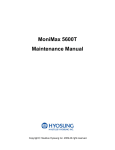
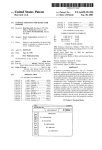
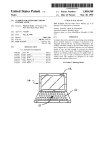
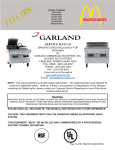
![[quote(var.text)]}](http://vs1.manualzilla.com/store/data/005937533_1-4dd3fe8a9b5a28fbfb6fbb268c8e3b66-150x150.png)
